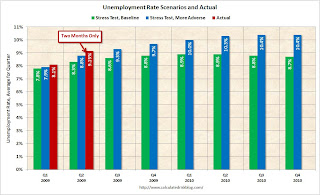The S&P Case-Shiller home price index for April 2009 was released today by Standard and Poors. The composite-10 declined 0.67% in April compared to March 2009 (last month it declined by 2.10%) and declined by 18.01% from a year ago (compared to 18.68% last month).

The composite-10 is now down 33.56% from its peak. The Composite-10 has now declined at a slower pace year over year for three months in a row after declining at a faster pace each month for 25 months in a row. The home price index is not seasonally adjusted. In the last 20 years, home prices have averaged appreciation of 5.29% a year. March through August are typically the strongest months for appreciation and home prices have on average appreciated by 4.40% during that 6 month period. September through February are the weakest months; home prices have on average appreciated by only 0.89% during that 6 month period. In the next month or two, the index could post a positive month over month gain. However, I expect it to fall again as we head into the winter months.
The CME futures market is pricing in a further drop of -10.20% by next March for the composite-10.





You can click on the images for a larger view.
Sphere: Related Content





